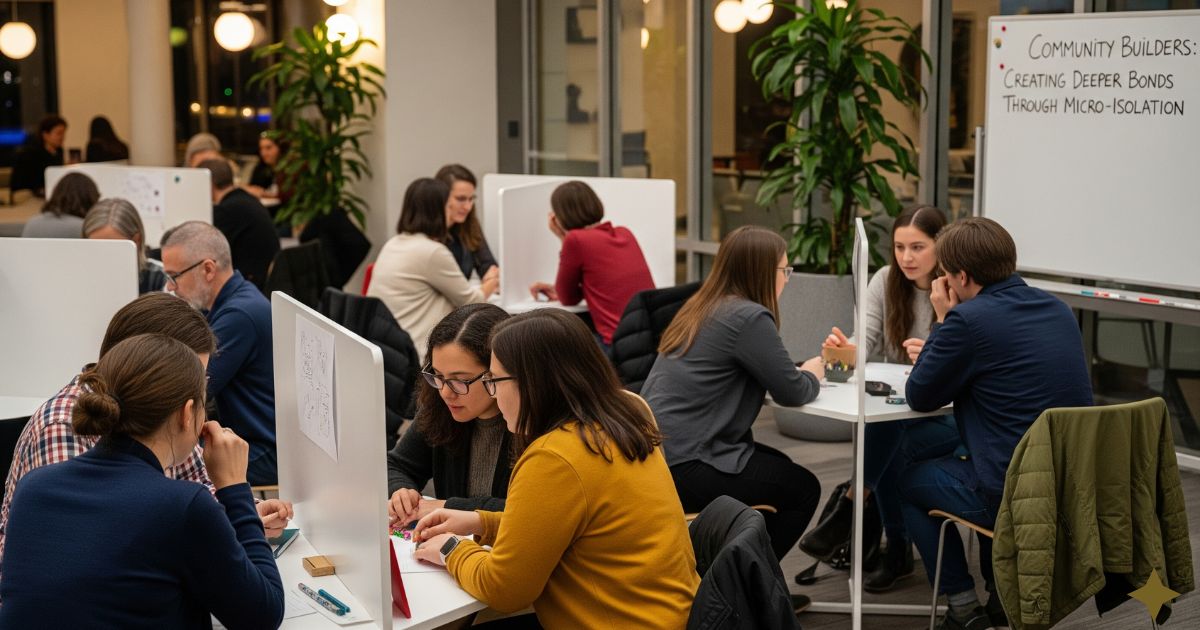Modern community builders are reshaping how we connect, often using intentional micro-isolation to foster stronger, more meaningful bonds. By carefully designing smaller, focused environments, they create opportunities for deeper trust, richer social relationships, and tighter community bonds.
While this approach might seem counterintuitive, it encourages people to engage more authentically, strengthening healthy relationships and making connections more resilient over time. In a world where superficial interactions are common, these strategies show how thoughtful design can turn brief moments of solitude into powerful tools for connection.
What is a community builder?
A community builder is someone who brings people together around a shared purpose, interest, or goal. They create spaces—online or offline—where individuals feel connected, supported, and engaged. Community builders foster collaboration, encourage participation, and help strengthen social relationships by organizing events, facilitating conversations, or providing resources that bring people closer. Whether it’s a local neighborhood group, a professional network, or an online forum, community builders play a crucial role in creating bonds, promoting trust, and building a sense of belonging.

Vulnerability Gaps: Engineering Emotional Rescue
The most sophisticated community builders don’t just create isolation – they engineer complete emotional journeys that move members through loneliness toward profound connection.
Rachel Kim runs a professional networking community for tech executives that uses what she calls “vulnerability gaps.” New members go through a carefully designed onboarding process that initially makes them feel overwhelmed and disconnected.
During their first week, new members receive minimal guidance and struggle to find their place within established social dynamics. Many report feeling lost and considering leaving the community entirely.
Then, at precisely the right moment, existing members reach out with personalized support and connection. This “rescue” creates bonds that feel authentic and meaningful because they emerged from genuine emotional need.
Kim tracks member retention data that shows people who experience this vulnerability gap stay active 340% longer than those who receive traditional welcome support from day one.
The psychological principle behind vulnerability gaps taps into our deepest social survival instincts. When someone helps us during moments of genuine distress, we form attachments that feel life-saving rather than merely convenient.
For comprehensive strategies on building authentic community connections, explore expert resources at buildbonding.
The Gaming Industry’s Mastery of Social Hunger
Online gaming communities have perfected loneliness architecture through systems that most players never recognize as psychological manipulation.
Popular games like World of Warcraft don’t just use temporary bans for rule enforcement. They strategically implement “cooling off periods” for valuable players who show signs of decreasing engagement. These brief suspensions create social hunger that drives players back with renewed intensity.
Guild systems in gaming represent perhaps the most sophisticated example of engineered belonging. New players often struggle to find groups, experiencing genuine loneliness and frustration. When they finally gain acceptance into a guild, the relief creates lasting loyalty that keeps them playing for years.
The most successful gaming communities balance exclusion with inclusion so precisely that players never question whether their social experiences are being deliberately manipulated. They simply feel grateful for the connections they’ve found.
Advanced gaming platforms now use machine learning algorithms to identify optimal moments for triggering social hunger in individual players. The system monitors engagement patterns and automatically creates personalized isolation experiences designed to maximize attachment.
Religious Communities and Historical Precedent
Modern community builders didn’t invent loneliness architecture. Religious organizations have used isolation-then-integration cycles for centuries to create profound spiritual bonds.
Many religious retreats begin with periods of deliberate isolation where participants feel disconnected from both their normal lives and their spiritual community. This manufactured spiritual loneliness creates hunger for the divine connection that the retreat ultimately provides.
Monastic traditions across cultures use similar principles. Novices often experience months of social isolation before gaining full acceptance into religious communities. This process creates bonds with their spiritual family that feel deeper than biological relationships.
Understanding these historical patterns helps modern community builders recognize that loneliness architecture taps into fundamental human psychological needs rather than exploiting temporary vulnerabilities.
The key difference lies in intention and outcome. Religious communities typically use isolation to create genuine spiritual transformation, while some modern applications focus purely on engagement metrics and retention rates.
Digital Platforms and Artificial Connection Barriers
Social media platforms have discovered that making connections slightly difficult increases the psychological value of each interaction.
Instagram’s algorithm doesn’t just show users content they want to see. It deliberately withholds some desired content to create social hunger. When users finally see posts from accounts they care about, the delayed gratification creates stronger emotional responses than immediate access would generate.
Dating apps use similar principles by limiting daily matches and creating artificial scarcity around potential connections. Users who might feel overwhelmed by unlimited options instead experience hunger for each new match opportunity.
LinkedIn has perfected professional loneliness architecture through invitation systems that make networking feel exclusive. The platform could easily connect anyone with shared interests, but instead creates barriers that make each new professional connection feel valuable and meaningful.
These platforms understand that easy access to unlimited social connections actually reduces the psychological value of individual relationships. Artificial scarcity makes each connection feel more precious and emotionally significant.
The Neuroscience of Social Starvation
Recent neuroscience research reveals why loneliness architecture works so effectively at the biological level.
When people experience social isolation, their brains activate the same reward pathways associated with physical hunger. This creates measurable chemical cravings for social connection that feel as urgent as food or water needs.
Dr. Matthew Lieberman’s research at UCLA shows that social pain activates identical brain regions as physical pain. Community builders who understand this can create controlled social discomfort that generates powerful motivation for reconnection.
The brain’s reward system releases dopamine not just when social needs are met, but in anticipation of meeting those needs. This means the period of loneliness itself can become psychologically addictive if it consistently leads to meaningful connections.
Advanced community builders monitor these neurological patterns to optimize their isolation-integration cycles for maximum emotional impact without causing genuine psychological harm.
Ethical Boundaries in Loneliness Design
The power of loneliness architecture raises important questions about manipulation versus authentic community building.
Ethical practitioners focus on creating genuine value through controlled vulnerability rather than exploiting psychological weaknesses for purely commercial purposes. The isolation should serve the community member’s long-term well-being rather than just increasing platform engagement.
Transparency becomes crucial. While revealing the specific mechanics might reduce effectiveness, community builders should maintain honest intentions about helping members form meaningful connections rather than simply maximizing retention metrics.
The duration and intensity of isolation periods require careful calibration. Brief moments of social hunger can strengthen bonds, while extended isolation can cause genuine psychological harm that undermines community trust.
Regular assessment of member well-being helps distinguish between healthy vulnerability creation and harmful manipulation. Successful loneliness architects monitor not just engagement metrics but emotional outcomes for community participants.
Implementation Strategies for Community Managers

Effective loneliness architecture requires subtle implementation that feels natural rather than calculated.
Onboarding processes can include controlled challenges that make new members work slightly harder for acceptance. This effort creates psychological investment that wouldn’t exist with immediate inclusion.
Content access can be tiered in ways that create hunger for deeper community participation. Members who engage more actively gain access to exclusive discussions and resources that feel valuable precisely because they’re not universally available.
Event scheduling can incorporate elements of scarcity that make participation feel special. Limited attendance numbers or exclusive invitations create social hunger that transforms ordinary meetups into highly valued experiences.
Recognition systems work most effectively when they’re slightly difficult to achieve. Awards and status levels that require genuine effort create pride and attachment that wouldn’t develop through automatic recognition.
The Dark Side of Social Manipulation
Not all applications of loneliness architecture serve healthy community-building purposes.
Some platforms use isolation tactics primarily to increase addiction and screen time rather than foster genuine human connection. These systems create social hunger that can never be fully satisfied, leading to compulsive usage patterns.
Extremist groups have perfected loneliness architecture to create dangerous loyalty through cycles of exclusion and acceptance. Members who experience this manipulation often develop an attachment that overrides critical thinking about group activities.
Commercial communities sometimes use artificial scarcity to drive purchasing decisions rather than build meaningful relationships. The isolation serves profit motives rather than human connection needs.
Recognizing these harmful applications helps ethical community builders maintain focus on genuine value creation rather than pure engagement optimization.
Building Authentic Vulnerability
The most successful loneliness architects create authentic opportunities for vulnerability rather than manufacturing artificial emotional experiences.
Genuine challenges that push community members slightly outside their comfort zones create natural opportunities for mutual support and connection. These experiences feel meaningful because they represent real growth rather than manipulated emotions.
Shared struggles that bring people together through common difficulties create bonds based on genuine mutual understanding. The vulnerability emerges from real circumstances rather than engineered scarcity.
Mentorship programs that pair experienced members with newcomers can create natural vulnerability gaps where both parties experience moments of uncertainty that deepen their connection through authentic support.
The key lies in designing systems that reveal genuine human needs rather than creating artificial ones for psychological manipulation.
Measuring Success Beyond Engagement
Traditional community metrics focus on participation rates and retention numbers, but loneliness architecture requires more sophisticated measurement approaches.
Emotional well-being surveys help determine whether isolation experiences create positive growth or harmful psychological effects. Members should report feeling more connected and supported rather than anxious or manipulated.
Relationship quality indicators matter more than quantity metrics. Successful loneliness architecture should produce deeper friendships and more meaningful interactions rather than just increased platform usage.
Long-term community health depends on members feeling genuine agency in their social experiences. People should choose to participate because they value the connections rather than feeling compelled by psychological manipulation.
Regular feedback collection helps community builders adjust their approaches based on actual member experiences rather than assumed psychological effects.
The Future of Connection Design
As our understanding of social psychology advances, loneliness architecture will likely become more sophisticated and prevalent across community platforms.
Artificial intelligence systems could personalize isolation experiences based on individual psychological profiles and emotional needs. Each member might receive customized vulnerability gaps designed for their specific attachment patterns.
Virtual reality environments could create immersive loneliness experiences that feel more authentic than current digital isolation methods. These platforms might simulate real-world social dynamics with unprecedented psychological precision.
However, growing awareness of these techniques may also lead to increased resistance and demand for transparent community building practices that prioritize genuine human connection over engagement optimization.
Conclusion: Engineering Authentic Connection
Loneliness architecture represents both the promise and peril of applied social psychology in community building. When used ethically, controlled vulnerability can help people form deeper, more meaningful connections than they might develop through purely positive social experiences.
The technique works because it taps into fundamental human needs for belonging and social security. Brief periods of uncertainty make the eventual connection feel more valuable and emotionally significant.
However, the power of these methods requires careful ethical consideration and genuine focus on member well-being rather than pure engagement metrics. The goal should be helping people build authentic relationships rather than exploiting psychological vulnerabilities for commercial purposes.
Understanding loneliness architecture helps both community builders and participants recognize when social experiences are being deliberately shaped to influence emotional responses. This awareness enables more conscious choices about which communities deserve our psychological investment and trust.





